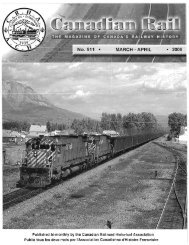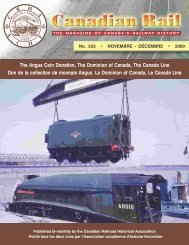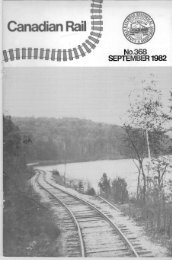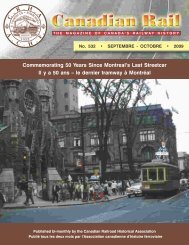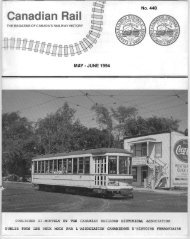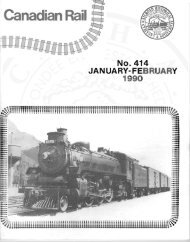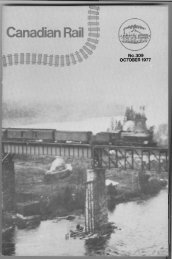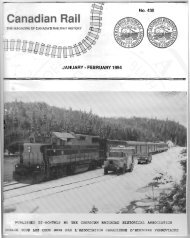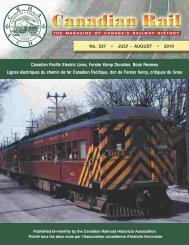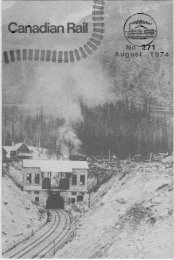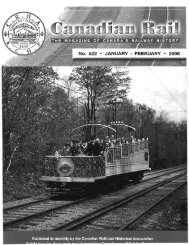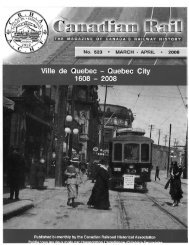Canadian Rail_no538_2010 - Le musée ferroviaire canadien
Canadian Rail_no538_2010 - Le musée ferroviaire canadien
Canadian Rail_no538_2010 - Le musée ferroviaire canadien
Create successful ePaper yourself
Turn your PDF publications into a flip-book with our unique Google optimized e-Paper software.
SEPTEMBER – OCTOBER <strong>2010</strong><br />
221 CANADIAN RAIL • 538<br />
Continued from page 207<br />
Deux Montagnes<br />
Deux Montagnes<br />
AMT train 940 pulls into Roxboro Station on<br />
September 8, 2008 with cab car 422 leading. The<br />
centre doors are designed for Central Station’s high<br />
platforms, while the end doors have vestibule steps<br />
for the commuter low platforms. Michael <strong>Le</strong>duc.<br />
<strong>Le</strong> train de l’AMT no 940 entre en gare de Roxboro en<br />
ce 8 septembre 2008 avec en tête la voiture avec<br />
cabine de conduite no 422. <strong>Le</strong>s portes centrales ont<br />
été conçues pour les quais élevés de la Gare Centrale<br />
tandis que celles des vestibules ont des marches<br />
adaptées au bas niveau des quais des gares de<br />
banlieue. Michael <strong>Le</strong>duc.<br />
Year service inaugurated / Année d’inauguration<br />
Number of stations / Nombre de gares<br />
Parking lots / Stationnements incitatifs<br />
Departures per week-day rush-hour / Départs en période de pointe (en semaine)<br />
On time performance (2009) / Ponctualité<br />
Daily ridership / Déplacements quotidiens<br />
1918<br />
12<br />
8<br />
25 / 24<br />
97.19%<br />
31,000<br />
In the first decade of the twentieth century, the<br />
<strong>Canadian</strong> Northern <strong>Rail</strong>way (CNoR) was being<br />
transformed from a regional railway in western Canada<br />
into a 16,093 (10,000 mile) transcontinental<br />
transportation system. The CNoR approached Montreal<br />
from Ottawa from the northwest via Hawkesbury and<br />
Deux-Montagnes.<br />
The CNoR was the last major railway to be built<br />
and rail access to downtown Montreal was limited. The<br />
Grand Trunk and <strong>Canadian</strong> Pacific lines had largely<br />
blocked access to the city from the south, west and<br />
northeast. Initially, the CNoR’s access to Montreal was<br />
via Pointe aux Trembles to the St. Catherine Street East<br />
Station located at Moreau and St. Catherine Streets. The<br />
<strong>Canadian</strong> Northern could not compete with <strong>Canadian</strong><br />
National or <strong>Canadian</strong> Pacific from this location.<br />
Located far east of the city centre, and unworthy<br />
of becoming a trans-continental railway station, Sir<br />
William Mackenzie and Sir Donald Mann adopted the<br />
bold and rather audacious proposal of Henry K.<br />
Wicksteed, then the Chief Engineer of Surveys for the<br />
CNoR to bore a railway tunnel under Mount Royal so as<br />
to bring their trains in to the heart of the downtown area.<br />
Rising 234 meters (769 feet) in height, Mount Royal<br />
dominated Montreal’s north side. This was the only<br />
obstruction to prevent the CNoR from reaching<br />
downtown Montreal from the north, Mount Royal (with<br />
Dans la première décennie du 20e siècle, le<br />
<strong>Canadian</strong> Northern <strong>Rail</strong>way (CNoR), à l’origine un<br />
chemin de fer régional de l’ouest du Canada, devint un<br />
réseau transcontinental de 16 093 km. D’Ottawa, le<br />
CNoR accédait à Montréal par le nord-ouest via<br />
Hawkesbury et Deux-Montagnes.<br />
Dernier-né des principaux chemins de fer<br />
<strong>canadien</strong>s de l’époque, il avait un accès limité au centreville<br />
de Montréal. En effet, le Grand Tronc et le<br />
Canadien Pacifique avaient accaparé les entrées sud,<br />
ouest et nord-est de la ville. <strong>Le</strong> CNoR ne pouvait y<br />
accéder que par Pointe-aux-Trembles pour se diriger<br />
ensuite vers la gare Moreau, située dans l’est de la ville à<br />
l’intersection des rues Moreau et Sainte-Catherine. <strong>Le</strong><br />
CNoR ne pouvait donc que difficilement concurrencer le<br />
Grand Tronc et le Canadien Pacifique.<br />
Face à cette situation, Sir William Mackenzie et<br />
Sir Donald Mann, fondateurs de l’entreprise, adoptèrent<br />
l’audacieuse proposition de leur ingénieur en chef, Henry<br />
K. Wicksteed : creuser un tunnel sous le mont Royal afin<br />
de fournir un accès au cœur de la ville. Cette montagne,<br />
seul obstacle pour atteindre le centre-ville du côté nord,<br />
domine la cité avec ses 234 m de hauteur. Situé au centre<br />
d’une vaste plaine, elle est composée principalement de<br />
roches volcaniques. Wicksteed songeait à construire près<br />
du terminus, au sud de la rue Sainte-Catherine, des tours<br />
de bureaux au-dessus des voies sortant du tunnel, en



